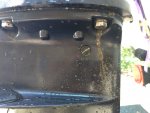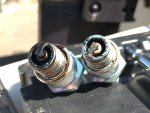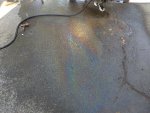BaylinerRyan
Cadet
- Joined
- Jul 27, 2020
- Messages
- 7
Hello everyone. I am hoping someone might be able to provide me a little advice. My father passed away and I inherited one of his old boats. Its a 14 foot 1987 Bayliner with the original Force 50. It has sat in a garage for the last 7 years and I figured I would see if I could get it running. I checked the 7 year old gas in it and was amazed that it still smelled decent. I was curious so I threw on a set of ears and a battery from my Jeep and the thing started after about 5 seconds of cranking. Needless to say I was amazed and figured the motor was in good shape. The exterior is very clean with absolutely minimal corrosion. It sounds strong and feels like it has plenty of compression.
Fast forward a few days and I notice a puddle of oil under the engine. Upon further inspection I could see that it had run out of the water intake. Some research on the forum led me to believe that the gearbox needed a seal kit. I ordered one and started to drop the lower unit. Well that was a fun experience. The long stud was pretty corroded in the housing and did not want to let go. A liberal application of PB Blaster and a torch eventually won. I was able to get all the old seals out and replaced with the new ones. Bolted everything together making sure o-ring between the gearbox and lower unit was in its channel. Everything seemed good.
I started the motor and ran it for a good 5-10 minutes. Everything sounded good and I did not see any evidence of oil or water mixing. I shut it down and let everything drain and after a half hour there was no sign of oil. I decided to put some Seafoam in the tank and run the motor for a while. I let it run for about 15 minutes and when I shut it down there was a grey milkshake that was pouring from the little drain hole behind one of the bolts that connects the lower unit to the main engine.
Some more info. I don't have a service manual so I was just using the knowledge I have gained from years of working on cars and Jeeps. When I initially saw the oil it was plain gear oil, not mixed with water and had come out the water intake. Now I have water and oil clearly mixed and running out the drain hole at the top of the lower unit. One thing I found troubling was that I am unable to remove the driveshaft. It appears that it has worn very badly on the bushing. I replaced the seal but the surface on the driveshaft is fairly worn in that spot too. Could that be the issue? I also did not use any type of sealer anywhere. Was that a mistake?
Thank you for any help you can provide and I apologize for the wall of text.
Fast forward a few days and I notice a puddle of oil under the engine. Upon further inspection I could see that it had run out of the water intake. Some research on the forum led me to believe that the gearbox needed a seal kit. I ordered one and started to drop the lower unit. Well that was a fun experience. The long stud was pretty corroded in the housing and did not want to let go. A liberal application of PB Blaster and a torch eventually won. I was able to get all the old seals out and replaced with the new ones. Bolted everything together making sure o-ring between the gearbox and lower unit was in its channel. Everything seemed good.
I started the motor and ran it for a good 5-10 minutes. Everything sounded good and I did not see any evidence of oil or water mixing. I shut it down and let everything drain and after a half hour there was no sign of oil. I decided to put some Seafoam in the tank and run the motor for a while. I let it run for about 15 minutes and when I shut it down there was a grey milkshake that was pouring from the little drain hole behind one of the bolts that connects the lower unit to the main engine.
Some more info. I don't have a service manual so I was just using the knowledge I have gained from years of working on cars and Jeeps. When I initially saw the oil it was plain gear oil, not mixed with water and had come out the water intake. Now I have water and oil clearly mixed and running out the drain hole at the top of the lower unit. One thing I found troubling was that I am unable to remove the driveshaft. It appears that it has worn very badly on the bushing. I replaced the seal but the surface on the driveshaft is fairly worn in that spot too. Could that be the issue? I also did not use any type of sealer anywhere. Was that a mistake?
Thank you for any help you can provide and I apologize for the wall of text.






















